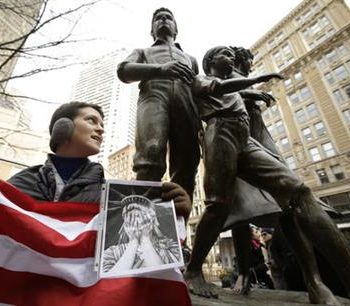By Thai V Le and Manuel Pastor | Orange County Register | MAY 20, 2022 | Photo by Sarah Reingewirtz
With sold out “Help Wanted” signs and businesses resorting to greater incentives to recruit and retain employees, it is clear that California’s labor shortage is real. Less acknowledged is that the labor shortage is not just a function of the pandemic: for the first time in its history, California has experienced population decline, which raises concerns about meeting labor demand across the long haul.
One of the ways that California has historically maintained a growing workforce has been through immigration. However, the share of the foreign-born in the state has also been on a steady decline, with the fall most stark in the Los Angeles and San Francisco counties. Part of what is driving immigrants away is what is affecting all Californians: a lack of quality jobs and the skyrocketing costs of housing.
In fact, unaffordability in California affects immigrants even more than others. The median wage for immigrants ($19.43) is lower than the median wage for U.S.-born workers ($26.22). Although naturalized citizens ($24.28) are more likely to gain wage parity with their U.S-born counterparts, the undocumented ($13.11) fare significantly worse as they face disproportionate barriers to entry to the labor market—ultimately because of their status.
Not surprisingly, immigrant-headed households are also more likely to experience rent burden (57.5%) and housing burden (35.2%) than households headed by U.S.-born Californians (51.8% and 28.9%, respectively). Housing unaffordability will continue to persist if policymakers are not able to address the core issues exacerbating rent and housing burden: a limited supply of affordable and accessible housing for all.
Competing for immigrants is new territory for the Golden State. After all, we generally think of ourselves as an immigrant-rich and immigrant-welcoming state. After our own bout of restriction in the 1990s – as evidenced most dramatically by the passage of Proposition 187, an attempt to strip undocumented immigrants of access to any benefits – California now brands itself proudly as a “sanctuary state” and political figures see gains in painting themselves as leaders in the fight for immigrant integration.
But, are these attitudes enough to attract and keep immigrants in California?
Not when wages for immigrants continue to lag, when a lack of legal status prevents full access to unemployment benefits or health insurance, and when the strain of high rents is felt disproportionately by immigrant households. After all, immigrants make their decisions about where to come and where to stay not just based on tone but also on material reality, as evidenced by trends showing high-cost traditional gateway destinations losing appeal to immigrants despite their immigrant-friendly policies.
Meanwhile, states that are known for their anti-immigrant rhetoric and discriminatory policies are seeing an uptick in their foreign-born population. Immigrants—when faced with choosing a state that diminishes your dignity but has housing you can afford—may choose economic security over safety and acceptance.
That’s not a dilemma anyone should face, and it’s one that is putting our economic future at risk. California needs to roll out the welcoming mat, but we need to couple our welcoming attitudes with actions that provide more accessible and meaningful opportunities for education, employment, and housing that would benefit all Californians, including immigrant families.
Three things need to happen to address this looming crisis: changing policy, changing power, and changing perspective.
Without a doubt, we need to address the disastrous combination of low wages and expensive housing—and there is a wealth of policy proposals to do just that. But, we won’t fully get there until we own up to the nature of our economy: one that produces both high-wage and low-wage employment, generally coupled together as our workers in high-tech, biotech, finance, and entertainment demand essential services in restaurants, child care, gardening, agriculture, and construction.
So, it’s fine to lure dynamic companies, but we need to couple our attempt to grow the top of the labor market with a commitment to lifting the bottom: greater increases in the minimum wage, a better framework for unionization and workers’ protection, and an expansion of the affordable housing stock. That also means that we can’t view immigrant attraction solely through the lens of relatively well-paid and well-educated H1-B workers; California must strategize and take actions on how to attract and retain immigrants of all skills to ensure labor demands are met, from day laborers to techies.
Changing policy requires power. It is on-the-ground advocacy work that helped drive statewide policies to improve healthcare coverage and disaster relief aid for undocumented immigrants in California. Changing power also means increasing immigrant representation in local politics and agencies to not only build trust with immigrant communities that have been the target of past discriminatory policies but also to ensure immigrant voices are at the table when policies are made.
And immigrants can’t do it alone. Business stakeholders and civic leaders need to stress our mutuality, emphasizing that immigrants are not only living among us but are also essential cogs in California’s cultural and economic engines. Leaders should also insist that immigrant worth and deservingness goes beyond economic contributions, particularly given the likelihood of more families that will be fleeing climate and other crises in Central America and elsewhere.
California can’t take immigrants for granted. We must match our welcoming rhetoric with actionable policies and genuine opportunities. At stake is not just our reputation as an immigrant-rich state; what also hangs in the balance is our ability to sustain the California Dream for generations to come.







